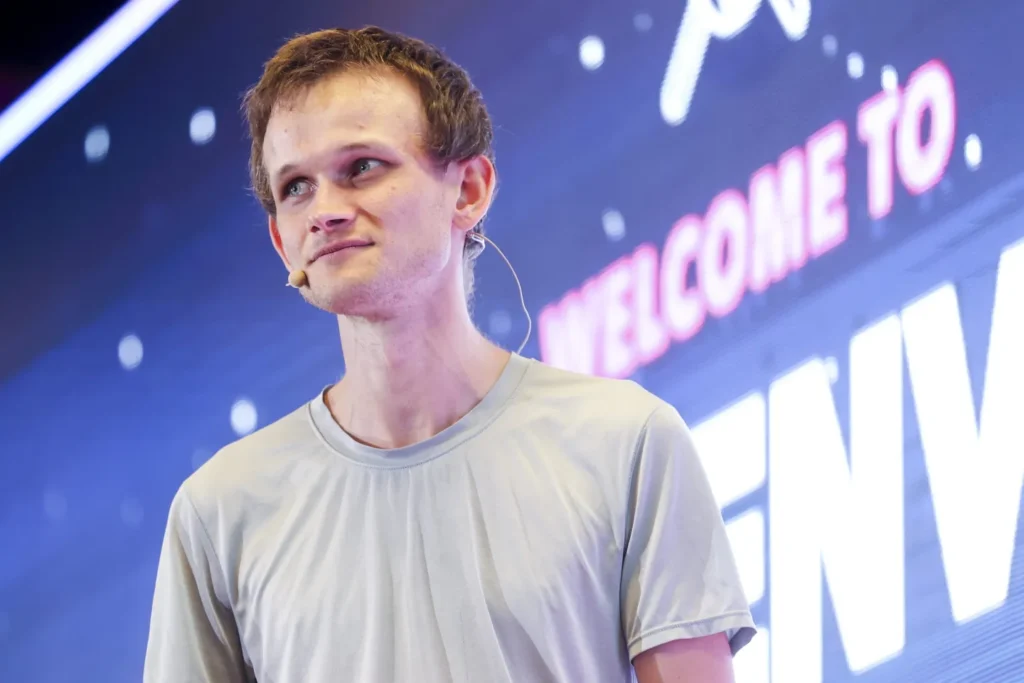Vitalik Buterin lacks the enigmatic mystery of the anonymous founder of Bitcoin, Satoshi Nakamoto. But he’s rapidly become one of cryptocurrency’s leading personalities.
Vitalik Buterin’s the co-founder of Ethereum (ETH), the second most popular crypto. With a market capitalization of more than INR 13 trillion, Ethereum is the biggest altcoin.
But beyond its dominant market position, Ethereum has shown the world that crypto can be more than just a store of value or a means of exchange. The leading altcoin offers an entirely novel paradigm for distributed computing.
Thanks to his technological innovations, his talents as a writer and a programmer, and above all his philosophical outlook on crypto, Vitalik Buterin is attempting to lead both cryptocurrency and financial markets as a whole out of the shadows and on to the blockchain.
Table of Contents
Vitalik Buterin Co-Founded Ethereum
Buterin laid the foundations of Ethereum in 2013 when he was just 19, writing a white paper that outlined “a next-generation smart contract and decentralized application platform.”
Buterin’s work took the groundbreaking development of Bitcoin’s underlying blockchain technology to the next level. He foresaw that blockchain technology could build different platforms with even greater possibilities, driven by smart contracts.
For those new to crypto, a smart contract is a self-executing program whose terms and rules are encoded on a blockchain. Think of the Uber App on your phone, minus both Uber the company and your phone. Smart contracts aim to ditch intermediaries of all kinds, enabling seamless, automatic, trackable and irreversible agreements between any parties.
The Russian-born developer proposed using blockchain-based smart contracts to encode all the assets and bylaws of entire organizations, allowing them to function without independent oversight.
The Ethereum blockchain became a reality when it launched two years after Buterin wrote his white paper, in July 2015.
Vitalik Buterin’s Early Life
Buterin was first introduced to Bitcoin (BTC) in his late teens by his father, a Russian-born engineer who had moved his family to Canada.
Without capital to invest in Bitcoin or cryptocurrency mining, Buterin chose to work as a blog writer for Bitcoin payments.
During the early 2010s, Buterin was approached by Mihai Alisie, a Romanian Bitcoin enthusiast, with the idea of starting a Bitcoin-centric publication. The two founded Bitcoin Magazine, the first major publication to cover cryptocurrency exclusively.
Although he considered the publication a side hustle while he attended the University of Waterloo in Ontario, Canada, Buterin quickly became a respected writer in the crypto sphere.
Buterin attended his first Bitcoin conference in San Jose, California, in 2012 before becoming an avid globe-trotter.
By the time he wrapped up his travels in 2014, Buterin was awarded a two-year, $100,000 Peter Thiel Fellowship to begin working on the Ethereum platform.
Vitalik Buterin’s start with crypto
Vitalik Buterin was reportedly introduced to Bitcoin in his late teens by his father Dmitry, who is himself a computer scientist. Buterin’s curiosity led him to deep dive into the technology, eventually earning Bitcoin by writing articles, and then cofounding Bitcoin Magazine in 2012. His exploration of the economic, technological, and political facets of cryptocurrency culminated in the realization that the blockchain could be used for broader applications. This revelation was the beginnings of the creation of Ethereum, which has since become a foundational platform for countless dapps and smart contracts, reshaping the landscape of digital transactions and decentralized governance.

Vitalik Buterin’s fascination with Bitcoin and the potential of the blockchain continued as he was enrolled in the University of Waterloo in computer science. It was during this time that Buterin wrote Ethereum’s 2013 whitepaper, which laid the foundation for Ethereum by detailing a blockchain with a built-in, fully-fledged Turing-complete programming language. This innovation enabled developers to encode a diverse range of operations, thereby expanding the blockchain’s utility beyond what was previously imaginable. The whitepaper resonated with the crypto community, and by January 2014, a core team, including Buterin, had formed to advance the project. Their efforts were funded through an initial coin offering (ICO) of ether, Ethereum’s native currency, which raised over $18 million.
Vitalik Buterin’s impact on cryptocurrency
Vitalik Buterin’s impact on cryptocurrency cannot be overstated. With the launch, development, and widespread adoption of Ethereum, Buterin has had profound effects on the crypto ecosystem that followed and essentially opened up the floodgates for developers to build all sorts of dapps on-chain, such as finance and gaming, significantly expanding blockchain’s use cases. Ethereum also laid the foundation for the decentralized finance (DeFi) movement, revolutionizing financial services by offering decentralized lending, borrowing, and trading platforms.
Additionally, Ethereum enabled the creation of tokens through its ERC-20 standard, leading to the proliferation of Initial Coin Offerings as a new fundraising mechanism. The platform’s support for non-fungible tokens (NFTs) revolutionized digital ownership and monetization in art, music, and gaming. Further, by enabling new governance models through decentralized autonomous organizations (DAOs), Ethereum has catalyzed the growth of the broader blockchain ecosystem and continues to shape the future of decentralized digital innovation.
Ethereum’s success has not, however, been without challenges. A prominent and ongoing issue facing the Ethereum platform has in a way been caused by its success: the sheer volume of transactions carried out on Ethereum has led to congestion and, at times, a dramatic rise in transaction fees. This spurred on the development of alternative blockchains which carry similar functionality as Ethereum, such as the support of dapps, but with faster transaction times and lower fees, such as Solana, BNB Smart Chain and Avalanche — as well as Layer 2 networks built on Ethereum.
The Birth of Ethereum
It was a watershed moment when Buterin’ dropped his white paper on Ethereum. The notion of developing a cryptocurrency as a utility leveraging blockchain technology broke new ground.
Buterin’s interest in blockchain led him to recommend developing applications that went well beyond a store of value or a means of exchange. But Bitcoin was not a workable platform for Buterin’s ideas, since its blockchain wasn’t designed to handle anything like the kinds of functionality that Buterin was proposing.
What he wanted to build was a platform for distributed computing. At the heart of his concept were decentralized autonomous organizations (DAOs)—based on smart contracts—an organizing structure built from the bottom up with no central authority. This insight is partly why you hear the word “decentralization” invoked in so many conversations surrounding cryptocurrency.

Vitalik Buterin said in his blog that because of the decentralized nature, “DAOs are not corporations.” Instead, they need to be structured to take on a greater ability to oversee themselves.
“A smart contract is a contract that enforces itself,” Vitalik Buterin said.
“We can have smart financial contracts that automatically shuffle money around based on certain formulas and conditions, smart domain name sale orders that give the domain to whoever first sends in INR 15,825. Perhaps, even smart insurance contracts that control bank accounts and automatically pay out based on some trusted source (or combination of sources), supplying data about real-world events,” he wrote in Bitcoin Magazine in February 2014.
Only a month before the publication of this commentary, Vitalik Buterin had unveiled the concept for the Ethereum platform at the North American Bitcoin Conference in Miami.
Co-founded by Buterin, Gavin Wood, Charles Hoskinson, Anthony Di Iorio and Joe Lubin, these principals retreated to a house where they hammered out code that would back up Buterin’s concept. Alisie, Amir Chetrit and Jeffrey Wilcke were later added to this list of co-founders.
Ethereum became the first smart contract platform in the world when it launched in July 2015.
Since then, the platform has launched a host of decentralized applications, including the first ever decentralized lending protocol known as MakerDAO, Decentraland (MANA)—a crypto gaming initiative—and the NFT marketplace OpenSea, and many more.
The Ethereum Merge
The biggest problem faced by Ethereum has been its massive energy consumption, thanks to its proof of work consensus mechanism.
With proof of work, crypto miners verify transactions by generating matching computer codes. To do this at the necessary speed requires tremendous amounts of computing power—and energy to run the computers that solve the complex equations.
At one point, a single Ethereum transaction used about as much energy as the average U.S. household consumes in a week. Before Ethereum upgraded to a proof-of-stake protocol, the network used more than 5 gigawatts (GW) of power.
Buterin recognized this problem early. In particular, he realized that to maintain the platform’s secure and decentralized nature under a proof-of-work protocol, massive amounts of energy consumption would be required.
He wanted to move away from this consumption for two reasons. First, as he says, it kills trees. Second, in his opinion, there was no advantage to those who defended the network.
To solve these problems, Buterin suggested the Ethereum network move away from a proof-of-work system to proof of stake. Under this consensus mechanism, network validators “stake” the platform’s native token—ETH—to secure their votes on which blocks get added to the underlying blockchain.
The change to proof of stake was at the heart of the Ethereum merge in 2022. The merge was completed in September 2022, decreasing the network’s power consumption by 99%, from 112 terawatts per hour annually (TWh/yr) to 0.01 (TWh/yr).
Vitalik Buterin’s Awards, Philanthropy and Net Worth
In addition to receiving a Peter Thiel Fellowship for the development of Ethereum, Vitalik Buterin (who dropped out of university) holds an honorary doctorate from the University of Basel. Also among his other accolades is a bronze medal in the 24th International Olympiad of Informatics in 2012.
Vitalik Buterin engages in a great deal of philanthropy. His contributions began in 2017 when he donated more than three-quarters of a million dollars in ETH to the Machine Intelligence Research Institute, an organization promoting the development of safer artificial intelligence.
Since then, Buterin has donated more than 100 crores in cryptocurrencies to various organizations worldwide.
“He hasn’t chased making as much money as possible or being famous. He’s chased building decentralized products and platforms and creating the world that a lot of people in this space think should exist,” says Andy Bromberg, CEO of fintech app Eco.
Based on the amount of ETH Buterin owns, his net worth is estimated at around INR 32 billion.
Vitalik Buterin’s Plans for the Future
Vitalik Buterin is involved in a handful of blockchain projects other than Ethereum, including L4, Plasma Group and more.
Given his original desire to make Ethereum a “world computer,” it’s been speculated that Buterin is interested in contributing to the coming metaverse.
“The “metaverse” is going to happen, but I don’t think any of the existing corporate attempts to intentionally create the metaverse are going anywhere,” Buterin said in a July 2022 tweet.
This was a direct attack on Meta Platform’s founder and CEO, Mark Zuckerberg, as Meta, formerly known as Facebook, attempts to gain a foothold in this coming world.
Vitalik Buterin struck another blow to the Facebook founder when he said, “We don’t really know the definition of ‘the metaverse’ yet. It’s far too early to know what people actually want. So anything Facebook creates now will misfire.”
But Andrew Bondarenko, founder and CEO of decentralized finance (DeFi) platform Tokonomo, says, “Buterin expects Ethereum to dominate the metaverse race in the next 10 years.”
Given everything the world is watching develop on the Ethereum platform—DeFi, non-fungible tokens (NFTs), stablecoins—this isn’t surprising.
In fact, concerning Zuckerberg and Meta, Bondarenko says, “Ethereum is much more ready to create its own democratic metaverse with a well-thought-out economy.”
“Ethereum has become not just a company, but a whole decentralized organization,” Bondarenko says.
As a result, Vitalik Buterin, at only 28, has already earned his seat at the table of crypto entrepreneurs. Next to Satoshi Nakamoto, Vitalik Buterin may be the most important person in the entire crypto-sphere.
Conclusions
In conclusion, Vitalik Buterin has played an irreplaceable role in the history and evolution of Ethereum. From co-founding the platform to leading the most recent updates like Ethereum 2.0, his vision and technical skills have been instrumental in shaping the direction and ongoing success of the network. Vitalik’s ability to anticipate challenges and design innovative solutions, as evidenced in the transition to Proof of Stake and the implementation of shard chains, has propelled Ethereum to the forefront of the blockchain revolution.

His commitment to decentralization, security, and scalability has left a lasting mark on how we conceive cryptocurrencies and decentralized applications. Beyond his technical contributions, Vitalik’s transparency and open communication have strengthened the Ethereum community. His leadership has inspired trust and collaboration, essential elements for the platform’s continuous development.
In essence, Vitalik Buterin’s figure is inseparable from the history and future of Ethereum. His bold vision and commitment to innovation have been and continue to be fundamental drivers in transforming the blockchain landscape.
Disclaimer ||
The Information provided on this website article does not constitute investment advice ,financial advice,trading advice,or any other sort of advice and you should not treat any of the website’s content as such.
Always do your own research! DYOR NFA
Coin Data Cap does not recommend that any cryptocurrency should be bought, sold or held by you, Do Conduct your own due diligence and consult your financial adviser before making any investment decisions!



